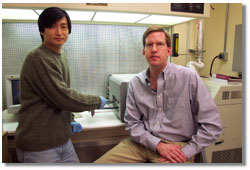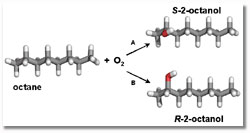 |
|
|
 |
||
|
||||||||||||||
|
For more information on these science news and feature story tips, contact the public information officer listed at (703) 292-8070. Editor: Josh Chamot Contents of this News Tip:
Researchers Break Electronics Speed Record
|
||||||||||||||
|
Engineers have fused a 1950s concept with modern semiconductor processing and design to create a diode that can move electrical current at record-breaking rates. At room temperature, the diode (a device that behaves like a valve for electricity traveling within a circuit) can transmit current equivalent to 151,000 amps per square centimeter, three times the rate of its closest competitors. For comparison, standard wiring in a home carries a maximum current density of only 700 amps per square centimeter. Known in the research community as a “resonant interband tunneling diode,” the silicon-based semiconductor has applications in computers and other electronic devices, and may eventually boost cellular phone signals to reach communications towers now beyond their range. Paul Berger, Niu Jin (lead author) and their colleagues at Ohio State University in Columbus, Phillip Thompson at the Naval Research Laboratory in Washington, D.C., and Roger Lake at the University of California at Riverside announced their world current record in the journal Applied Physics Letters. The researchers developed the diode with the support of the National Science Foundation (NSF), the independent federal agency that supports fundamental research and education across all fields of science and engineering. Tunneling diodes have been around since the late 1950’s when Leo Esaki, then at Sony Corp. in Japan, discovered that a property called tunneling can increase a diode’s output current. Esaki later won the Nobel Prize, in part for this work. Tunneling is a process that takes place at the level of the atom, in the realm of quantum physics. At that scale, the familiar rules of classical physics that guide rocket design, snowfall and baseball give way to less intuitive rules based on probability, waves and energy packets. Under the rules of quantum physics, an electron on one side of a barrier can travel through to the other side, “which would be like a tennis ball coming out the other side of a brick wall,” says Berger. The property is called tunneling, and while somewhat mysterious, researchers have been taking advantage of the phenomenon for years, although only in niche applications. By tweaking the properties of semiconductors, researchers can create materials that increase the chances that tunneling will occur. Berger and his team have optimized the diode design and the process for creating the device with few imperfections. The researchers also developed a manufacturing process to create tunneling diodes that, in addition to being incredibly fast, are silicon-based and easy to mass produce. The original tunnel diodes were difficult to mass produce and were not compatible with the silicon-based microchips that run modern electronics devices. By infusing silicon with large amounts of dopants (atoms in semiconductors that change the silicon crystal structure and allow electrons to flow) and controlling the temperatures at which the crystals grow, the team created a diode that was ideal for high-tunneling currents. The researchers are negotiating with a major electronics manufacturer to develop the device for uses in wireless and mixed-signal applications and have already integrated the diode with devices that are used in cell phones and standard computer chips in another NSF-supported project completed in conjunction with Rochester Institute of Technology. NSF Media Contact: Josh Chamot, (703) 292-7730, jchamot@nsf.gov Principal Investigator: Paul Berger, (614) 247-6235, pberger@ieee.org Paul Berger’s Homepage: http://eewww.eng.ohio-state.edu/~berger/ |
|
|
Researchers Coax Bacteria to Produce Powerful, Elusive Catalyst
|
Researchers have coaxed bacteria into producing a group of unique catalysts that can cleanly convert an alkane (a member of the carbon-based chemical family that includes octane) into specific alcohol products without also yielding unwanted molecules. Researchers have not been able to accomplish this result using other catalysts, and the approach may have broad applications in the chemical industry. In contrast to some industrial catalysts, these biocatalysts perform this difficult transformation in water, at room temperature, using oxygen from the air. The research also serves as a proof of concept for techniques that may help chemists convert some of Earth’s bountiful methane (the smallest alkane) into the chemical workhorse, and occasional automotive fuel, methanol. Matthew Peters, Frances Arnold, and colleagues from the California Institute of Technology introduced a range of mutations into bacterial DNA in a new approach to creating biocatalyst enzymes, announcing the research findings in the Journal of the American Chemical Society. The research was supported primarily by NSF. “We engineered unique, active sites on the catalyst molecule to hold these rather ‘slippery’ alkane molecules in such a way that the catalyst can create only a single product,” says Peters. To accomplish this, the researchers first shrank the size of the active site using directed evolution and a screening process involving small, propane-like substrates. Then, the researchers fine-tuned the molecule by introducing changes into the active site to reduce its size. The researchers started the process with an enzyme called P450 BM-3, which in its wild-type, or naturally occurring, form does not interact effectively with alkanes but completes a similar transformation with much larger compounds, the fatty acids. Produced by the Bacillus megaterium bacterium, P450 BM-3 is also relatively easy to manipulate in the laboratory. Peters removed segments of B. megaterium DNA that code for P450 BM-3 and simultaneously copied and randomly mutated them, targeting specific gene sites that could lead to useful changes. As a result, he created DNA instructions for thousands of potentially useful enzymes. "When we do this, instead of just amplifying the gene we end up making a library of genes with mistakes, or mutations, in them," says Peters. The researchers screened the libraries for candidates with beneficial mutations and improved their traits through several rounds of controlled evolution. “This work is pioneering the combined use of directed evolution and site-directed mutagenesis to find unique enzymes that produce industrially important products,” says Fred Heineken, acting director of NSF’s Division of Bioengineering and Environmental Systems. “In addition to the strong intellectual interest in the combined processes, the potential commercial use of these enzymes could have an enormous economic impact,” he added. Peters took the library of genes and inserted each segment into a different bacterial host. The researchers transferred the material into a strain of Escherichia coli bacteria, the white mice of genetics laboratories. Peters then developed a screening technique to find the mutants that could potentially work with the small alkanes. However, the enzymes at that stage did not seem able to yield large amounts of product. Peters decided to target genes at specific sections of the genetic code in a process called “site-directed mutagenesis.” These genetic changes altered parts of the enzyme the researchers suspected would be in direct contact with alkanes during the chemical reaction. “The successful enzymes incorporated a combination of mutations accumulated by rounds of directed evolution and site-directed mutations, each mutation tweaking them to be more effective,” says Peters. “These enzymes are capable of converting alkanes into single useful alcohols and are functional both in and out of their bacterial hosts.” While these biocatalysts are not yet competitive with current chemical and fermentation techniques for producing alcohols, the process was an important developmental step. “This was a proof of concept,” says Peters. “Our research proves that you can basically evolve enzymes to perform any task you desire—within certain limits.” The implications for processing methane are critical. “Right now, most methane is burned,” adds Peters, referring to its primary use as a fuel and the difficulties chemists face when trying to use the molecule for making new products. “It would be nice to be able to finally get methane into large-scale chemical processing by converting it into methanol, and this research will help us get there.” NSF Program Expert: Fred Heineken, fheineke@nsf.gov Principal Investigator: Frances Arnold, frances@cheme.caltech.edu The Frances Arnold Research Group: http://cheme.che.caltech.edu/groups/fha/ |
Larger versions (Total Size: 1,738KB) of all images from this document |
|
Arming Computers with Tools for Self-Defense
R.C. Sekar and colleagues at the State University of New York, Stony Brook, are working on self-defense tools to help computers protect themselves from common types of cyber attacks.
The most common cyber attacks exploit application errors to burrow into a computer’s memory. To deflect these precision strikes, the Stony Brook team developed a “smoke screen” that confuses and misdirects the memory attacks, dramatically reducing their effectiveness. The smoke screen has been applied to several common server applications, which the lab uses and has made available for download. According to Sekar, they expect to eventually provide tools to add the so-called “address obfuscation” technique to any application.
For untrusted programs downloaded from the Internet or arriving in e-mail, the lab has developed an isolation tool, called Alcatraz, to protect the rest of the system. As an untrusted program runs, all of its actions are confined within Alcatraz’s “walls.” Only when the user confirms that the actions were safe are the actions released to the rest of the system. System administrators could use the Alcatraz tool to perform trial software installations and check for conflicts or unwanted changes, malicious or otherwise.
The lab has also developed a “tripwire” that can detect statistical hiccups in the number and frequency of outgoing e-mail messages. The hiccups signal that a virus has hijacked an e-mail program. System administrators can set the tripwire on an outgoing mail server to detect even stealthy viruses on the systems for which they are responsible.
To prevent attacks before they happen, Sekar and C.R. Ramakrishnan are developing a tool for scanning a computer system’s overall configuration for vulnerabilities. A system administrator could then reconfigure a system before it goes online. However, this nascent effort requires more work before researchers will be able to model and analyze a real-world system automatically.
The tools have been developed with graduate students and post-doctoral researchers in Stony Brook’s Secure Systems Lab, which Sekar leads. The lab receives support from the National Science Foundation and the Office of Naval Research.
NSF Media Contact: David Hart, 703-292-7737, dhart@nsf.gov
Principal Investigator: R.C. Sekar, 631-632-5758, sekar@cs.cs.sunysb.edu
NSF Awards: 0098154, 0208877, 0205376, 0313858
SUNY Stony Brook Secure Systems Lab: http://seclab.cs.sunysb.edu/
|
|



